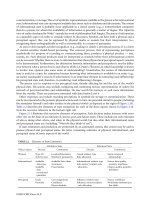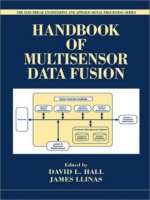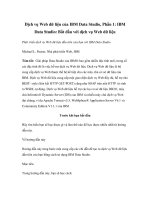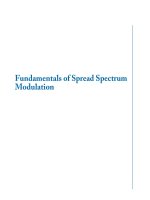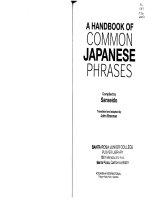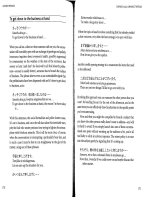handbook of multisensor data fusion phần 1 pot
Bạn đang xem bản rút gọn của tài liệu. Xem và tải ngay bản đầy đủ của tài liệu tại đây (207.94 KB, 6 trang )
©2001 CRC Press LLC
©2001 CRC Press LLC
I
Introduction
to Multisensor
Data Fusion
1 Multisensor Data Fusion
David L. Hall and James Llinas
Introduction • Multisensor Advantages • Military Applications • Nonmilitary
Applications • Three Processing Architectures • A Data Fusion Process Model •
Assessment of the State of the Art • Additional Information
2 Revisions to the JDL Data Fusion Model
Alan N. Steinberg and
Christopher L. Bowman
Introduction • What Is Data Fusion? What Isn’t? • Models and Architectures • Beyond
the Physical • Comparison with Other Models • Summary
3 Introduction to the Algorithmics of Data Association in Multiple-Target
Tracking
Jeffrey K. Uhlmann
Introduction •Ternary Trees • Priority
kd
-Trees • Conclusion • Acknowledgments
4 The Principles and Practice of Image and Spatial Data Fusion
Ed Waltz
Introduction • Motivations for Combining Image and Spatial Data • Defining Image and
Spatial Data Fusion • Three Classic Levels of Combination for Multisensor Automatic Target
Recognition Data Fusion • Image Data Fusion for Enhancement of Imagery Data • Spatial
Data Fusion Applications • Summary
5 Data Registration
Richard R. Brooks and Lynne Grewe
Introduction • Registration Problem • Review of Existing Research • Registration Using
Meta-Heuristics • Wavelet-Based Registration of Range Images • Registration
Assistance/Preprocessing • Conclusion • Acknowledgments
6 Data Fusion Automation: A Top-Down Perspective
Richard Antony
Introduction • Biologically Motivated Fusion Process Model • Fusion Process Model
Extensions • Observations • Acknowledgments
7 Contrasting Approaches to Combine Evidence
Joseph W. Carl
Introduction • Alternative Approaches to Combine Evidence • An Example Data Fusion
System • Contrasts and Conclusion • Appendix 7.A The Axiomatic Definition of
Probability
©2001 CRC Press LLC
1
Multisensor
Data Fusion
1.1 Introduction
1.2 Multisensor Advantages
1.3 Military Applications
1.4 Nonmilitary Applications
1.5 Three Processing Architectures
1.6 A Data Fusion Process Model
1.7 Assessment of the State of the Art
1.8 Additional Information
Reference
Integration or fusion of data from multiple sensors improves the accuracy of applications ranging from
target tracking and battlefield surveillance to nondefense applications such as industrial process moni-
toring and medical diagnosis.
1.1 Introduction
In recent years, significant attention has focused on multisensor data fusion for both military and
nonmilitary applications. Data fusion techniques combine data from multiple sensors and related infor-
mation to achieve more specific inferences than could be achieved by using a single, independent sensor.
The concept of multisensor data fusion is hardly new. As humans and animals have evolved, they have
developed the ability to use multiple senses to help them survive. For example, assessing the quality of
an edible substance may not be possible using only the sense of vision; the combination of sight, touch,
smell, and taste is far more effective. Similarly, when vision is limited by structures and vegetation, the
sense of hearing can provide advanced warning of impending dangers. Thus, multisensory data fusion
is naturally performed by animals and humans to assess more accurately the surrounding environment
and to identify threats, thereby improving their chances of survival.
While the concept of data fusion is not new, the emergence of new sensors, advanced processing
techniques, and improved processing hardware have made real-time fusion of data increasingly viable.
Just as the advent of symbolic processing computers (e.g., the SYMBOLICs computer and the Lambda
machine) in the early 1970s provided an impetus to artificial intelligence, recent advances in computing
and sensing have provided the capability to emulate, in hardware and software, the natural data fusion
capabilities of humans and animals. Currently, data fusion systems are used extensively for target tracking,
automated identification of targets, and limited automated reasoning applications. Data fusion technol-
ogy has rapidly advanced from a loose collection of related techniques to an emerging true engineering
David L. Hall
The Pennsylvania State University
James Llinas
State University of New York
©2001 CRC Press LLC
2
Revisions to the JDL
Data Fusion Model
2.1 Introduction
2.2 What Is Data Fusion? What Isn’t?
The Role of Data Fusion • Definition of Data Fusion
2.3 Models and Architectures
Data Fusion “Levels” • Association and Estimation • Context
Sensitivity and Situation Awareness • Attributive and
Relational Functions
2.4 Beyond the Physical
2.5 Comparison with Other Models
Dasarathy’s Functional Model • Bedworth and O'Brien’s
Comparison among Models and Omnibus
2.6 Summary
References
2.1 Introduction
The data fusion model, developed in 1985 by the U.S. Joint Directors of Laboratories (JDL) Data Fusion
Group*, with subsequent revisions, is the most widely used system for categorizing data fusion-related
functions. The goal of the JDL Data Fusion Model is to facilitate understanding and communication
among acquisition managers, theoreticians, designers, evaluators, and users of data fusion techniques to
permit cost-effect system design, development, and operation.
1,2
This chapter discusses the most recent model revision (1998): its purpose, content, application, and
relation to other models.
3
2.2 What Is Data Fusion? What Isn’t?
2.2.1 The Role of Data Fusion
Often, the role of data fusion has been unduly restricted to a subset of the relevant processes. Unfortu-
nately, the universality of data fusion has engendered a profusion of overlapping research and develop-
ment in many applications. A jumble of confusing terminology (illustrated in Figure 2.1) and ad hoc
methods in a variety of scientific, engineering, management, and educational disciplines obscures the
fact that the same ground has been plowed repeatedly.
*Now recharted as the Data and Information Fusion Group within the Deputy Director for Research and Engi-
neering’s Information System Technology Panel at the U.S. Department of Defense.
Alan N. Steinberg
Utah State University
Christopher L. Bowman
Consultant
©2001 CRC Press LLC
3
Introduction to the
Algorithmics of Data
Association in
Multiple-Target Tracking
3.1 Introduction
Keeping Track • Nearest Neighbors • Track Splitting and
Multiple Hypotheses • Gating • Binary Search and
kd
-Trees
3.2 Ternary Trees
3.3 Priority
kd
-Trees
Applying the Results
3.4 Conclusion
Acknowledgments
References
3.1 Introduction
When a major-league outfielder runs down a long fly ball, the tracking of a moving object looks easy.
Over a distance of a few hundred feet, the fielder calculates the ball’s trajectory to within an inch or two
and times its fall to within milliseconds. But what if an outfielder were asked to track 100 fly balls at
once? Even 100 fielders trying to track 100 balls simultaneously would likely find the task an impossible
challenge.
Problems of this kind do not arise in baseball, but they have considerable practical importance in other
realms. The impetus for the studies described in this chapter was the Strategic Defense Initiative (SDI),
the plan conceived in the early 1980s for defending the U.S. against a large-scale nuclear attack. According
to the terms of the original proposal, an SDI system would be required to track tens or even hundreds of
thousands of objects — including missiles, warheads, decoys, and debris — all moving at speeds of up to
8 kilometers per second. Another application of multiple-target tracking is air-traffic control, which
attempts to maintain safe separations among hundreds of aircraft operating near busy airports. In particle
physics, multiple-target tracking is needed to make sense of the hundreds or thousands of particle tracks
emanating from the site of a high-energy collision. Molecular dynamics has similar requirements.
The task of following a large number of targets is surprisingly difficult. If tracking a single baseball,
warhead, or aircraft requires a certain measurable level of effort, then it might seem that tracking 10 similar
objects would require at most 10 times as much effort. Actually, for the most obvious methods of solving
the problem, the difficulty is proportional to the square of the number of objects; thus, 10 objects demand
100 times the effort, and 10,000 objects increase the difficulty by a factor of 100 million. This combinatorial
explosion is a first hurdle to solving the multiple-target tracking problem. In fact, exploiting all information
Jeffrey K. Uhlmann
University of Missouri
